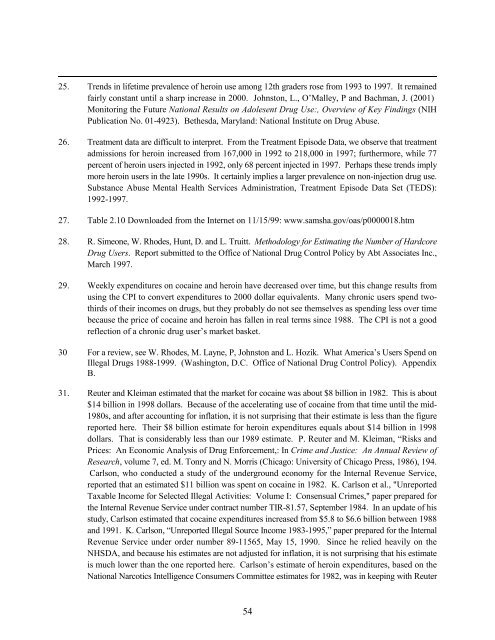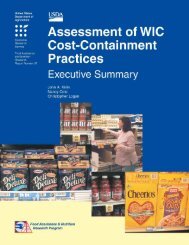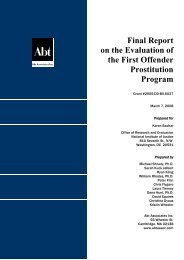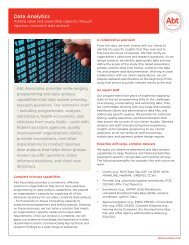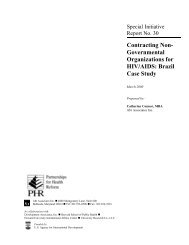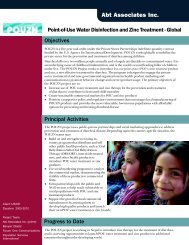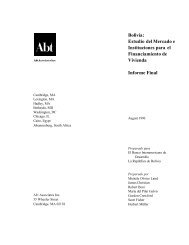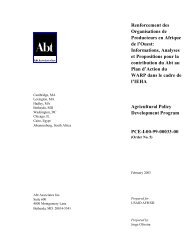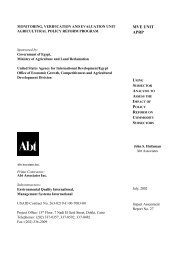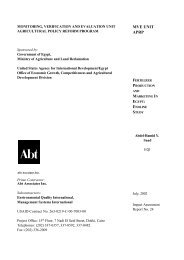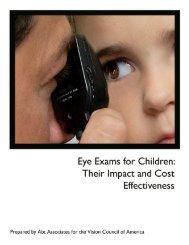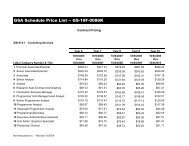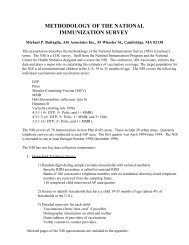What America's Users Spend on Illegal Drugs 1988-2000 - National ...
What America's Users Spend on Illegal Drugs 1988-2000 - National ...
What America's Users Spend on Illegal Drugs 1988-2000 - National ...
- No tags were found...
You also want an ePaper? Increase the reach of your titles
YUMPU automatically turns print PDFs into web optimized ePapers that Google loves.
25. Trends in lifetime prevalence of heroin use am<strong>on</strong>g 12th graders rose from 1993 to 1997. It remainedfairly c<strong>on</strong>stant until a sharp increase in <strong>2000</strong>. Johnst<strong>on</strong>, L., O’Malley, P and Bachman, J. (2001)M<strong>on</strong>itoring the Future Nati<strong>on</strong>al Results <strong>on</strong> Adolesent Drug Use:, Overview of Key Findings (NIHPublicati<strong>on</strong> No. 01-4923). Bethesda, Maryland: Nati<strong>on</strong>al Institute <strong>on</strong> Drug Abuse.26. Treatment data are difficult to interpret. From the Treatment Episode Data, we observe that treatmentadmissi<strong>on</strong>s for heroin increased from 167,000 in 1992 to 218,000 in 1997; furthermore, while 77percent of heroin users injected in 1992, <strong>on</strong>ly 68 percent injected in 1997. Perhaps these trends implymore heroin users in the late 1990s. It certainly implies a larger prevalence <strong>on</strong> n<strong>on</strong>-injecti<strong>on</strong> drug use.Substance Abuse Mental Health Services Administrati<strong>on</strong>, Treatment Episode Data Set (TEDS):1992-1997.27. Table 2.10 Downloaded from the Internet <strong>on</strong> 11/15/99: www.samsha.gov/oas/p0000018.htm28. R. Sime<strong>on</strong>e, W. Rhodes, Hunt, D. and L. Truitt. Methodology for Estimating the Number of HardcoreDrug <str<strong>on</strong>g>Users</str<strong>on</strong>g>. Report submitted to the Office of Nati<strong>on</strong>al Drug C<strong>on</strong>trol Policy by Abt Associates Inc.,March 1997.29. Weekly expenditures <strong>on</strong> cocaine and heroin have decreased over time, but this change results fromusing the CPI to c<strong>on</strong>vert expenditures to <strong>2000</strong> dollar equivalents. Many chr<strong>on</strong>ic users spend twothirdsof their incomes <strong>on</strong> drugs, but they probably do not see themselves as spending less over timebecause the price of cocaine and heroin has fallen in real terms since <strong>1988</strong>. The CPI is not a goodreflecti<strong>on</strong> of a chr<strong>on</strong>ic drug user’s market basket.30 For a review, see W. Rhodes, M. Layne, P, Johnst<strong>on</strong> and L. Hozik. <str<strong>on</strong>g>What</str<strong>on</strong>g> America’s <str<strong>on</strong>g>Users</str<strong>on</strong>g> <str<strong>on</strong>g>Spend</str<strong>on</strong>g> <strong>on</strong><strong>Illegal</strong> <strong>Drugs</strong> <strong>1988</strong>-1999. (Washingt<strong>on</strong>, D.C. Office of Nati<strong>on</strong>al Drug C<strong>on</strong>trol Policy). AppendixB.31. Reuter and Kleiman estimated that the market for cocaine was about $8 billi<strong>on</strong> in 1982. This is about$14 billi<strong>on</strong> in 1998 dollars. Because of the accelerating use of cocaine from that time until the mid-1980s, and after accounting for inflati<strong>on</strong>, it is not surprising that their estimate is less than the figurereported here. Their $8 billi<strong>on</strong> estimate for heroin expenditures equals about $14 billi<strong>on</strong> in 1998dollars. That is c<strong>on</strong>siderably less than our 1989 estimate. P. Reuter and M. Kleiman, “Risks andPrices: An Ec<strong>on</strong>omic Analysis of Drug Enforcement,: In Crime and Justice: An Annual Review ofResearch, volume 7, ed. M. T<strong>on</strong>ry and N. Morris (Chicago: University of Chicago Press, 1986), 194.Carls<strong>on</strong>, who c<strong>on</strong>ducted a study of the underground ec<strong>on</strong>omy for the Internal Revenue Service,reported that an estimated $11 billi<strong>on</strong> was spent <strong>on</strong> cocaine in 1982. K. Carls<strong>on</strong> et al., "UnreportedTaxable Income for Selected <strong>Illegal</strong> Activities: Volume I: C<strong>on</strong>sensual Crimes," paper prepared forthe Internal Revenue Service under c<strong>on</strong>tract number TIR-81.57, September 1984. In an update of hisstudy, Carls<strong>on</strong> estimated that cocaine expenditures increased from $5.8 to $6.6 billi<strong>on</strong> between <strong>1988</strong>and 1991. K. Carls<strong>on</strong>, “Unreported <strong>Illegal</strong> Source Income 1983-1995,” paper prepared for the InternalRevenue Service under order number 89-11565, May 15, 1990. Since he relied heavily <strong>on</strong> theNHSDA, and because his estimates are not adjusted for inflati<strong>on</strong>, it is not surprising that his estimateis much lower than the <strong>on</strong>e reported here. Carls<strong>on</strong>’s estimate of heroin expenditures, based <strong>on</strong> theNati<strong>on</strong>al Narcotics Intelligence C<strong>on</strong>sumers Committee estimates for 1982, was in keeping with Reuter54


